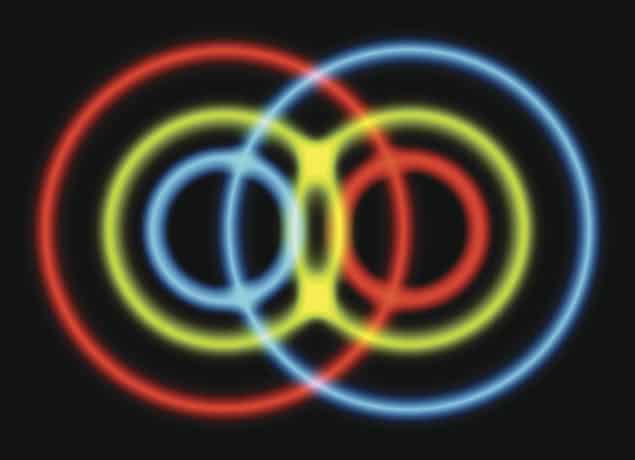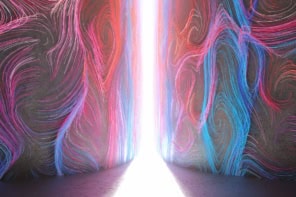
A technique for remotely entangling ions of strontium much more accurately and at far higher rates than previously possible has been unveiled by physicists in the UK. The team says that their scheme paves the way to scalable quantum computers made from multiple ion traps that are linked to one another via photonic interconnects.
Quantum computers promise to greatly outperform even the most powerful conventional computers on certain tasks. While some progress has been made, many challenges remain – including how to achieve the quantum entanglement of large numbers of quantum bit (qubits).
Trapped ions offer a way of generating qubits with very low levels of noise, and therefore maintain the quantum coherence that is required to perform calculations. Indeed, the quantum states of ions have been made to persist for over 10::min. Each ion is held in a vacuum using electric fields and is suspended over a micro-fabricated chip. Manipulated by laser beams, the ions can then be placed in a superposition and entangled with their neighbours.
Wiring and laser beams
Although the coherence times of rival technologies based on bulk matter are often far shorter – superconducting qubits, for example, generally last for less than a thousandth of a second – ion traps are relatively slow and are limited in the numbers of qubits they can store. This is because it becomes increasingly difficult to accommodate the wiring and laser beams needed as more qubits are added.
As such, researchers are exploring ways of connecting ion qubits in different traps. In the latest work, Christopher Ballance and colleagues at Oxford University have shown how to link trapped ions by entangling them using the photons they emit when excited by a laser beam. This technique was first realized by Chris Monroe and colleagues at the University of Maryland in the US, and now the Oxford group has boosted both the rate and fidelity of the entanglement by collecting more of the photons given off by the ions and by limiting imperfections in the emission process.
Their experiment involves generating a sequence of very short laser pulses, splitting each pulse in two and then directing each half of that pulse to an ion of strontium-88. Each of the excited ions then decays to a superposition of two different energy levels, causing it to emit a photon whose polarization is entangled with that of the ion. The train of photons emerging from each half of the experiment is then focused by a lens and fed into a length of fibre-optic cable.
The ions are entangled by directing the photons that emerge from the fibres onto a beam splitter, with the output from that monitored by two detectors. It is when both detectors click that the ions become entangled. The quality, or “fidelity”, of the entangled state is obtained through a Bell-state measurement. With the ions separated by 5::m of optical fibre, Ballance says that the technique provides entanglement over a sufficiently long distance to network many quantum computers together.
As they report on the arXiv server, the researchers found that they could generate, on average, 182 entangled ion pairs per second, with a fidelity of 94%. This compares to a rate of just five entangled pairs per second that was achieved by Monroe’s group in 2014, and a mere 0.001 every second in 2007.
“A big deal”
Monroe says the Oxford result “is a big deal, and the most recent demonstration of the fast-improving rate of off-chip quantum communication between ions”. He reckons it should be possible to push the rate well beyond 1000 entangled pairs per second, at which point, he says, “it is approaching the speed of local ion-ion operations and therefore useful for scaling.”
In fact, Ballance reckons that it might be possible to improve the latest rate by a factor of up to 100, in part by replacing the 5::cm-diameter lenses currently used to direct photons with reflective surfaces that can be placed much closer to the ions – and therefore collect more light. As with classical computers, he says that the aim is to “get to the point where the interconnect is not the bottleneck”.
Ballance says that the qubits’ long coherence times could make them ideal computer processors, as well as memories. To make his point he refers to Google’s recent report of “quantum supremacy”, which involved carrying out an operation claimed to be impossible on a classical computer in any reasonable amount of time. Although describing the result as a “milestone” in quantum computing, he argues that it also demonstrated the limitation of superconducting qubits – given their short-lived quantum states. The company’s researchers, he says, “have to improve memory to increase performance”.
Another possible use of remotely entangled ion qubits, adds Ballance, is the deployment of high-precision quantum sensors over large areas.
Rainer Blatt works on trapped ions at the University of Innsbruck in Austria and describes the latest work as “a nice technical achievement” that provides “good progress on the way to real-world applications”. But he cautions that in future the technique will have to be applied in the presence of more ions, perhaps to link two quantum computer nodes or to develop a quantum repeater. “There will be certainly more technological problems before such devices are readily available,” he says.
The research is described in preprint on arXiv.



